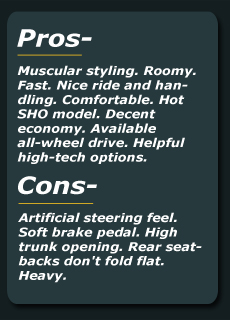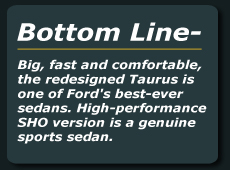2010 Ford Taurus
Prices $25,170-$37,170
ASHEVILLE, North Carolina--The original 1986 Taurus sedan was a styling
sensation for an American car with its Audi-influenced aerodynamic
lines and soon proved to be a perfect family car--and a best-seller.
The redesigned 2010 Taurus also is a solid family sedan, but is more
driver-oriented than the original, without sacrificing practicality.
The new Taurus has the same 112.9-inch wheelbase as the 2009 version,
but is slightly longer at 202.9 inches, about two inches wider and
nearly an inch lower. Its nicely sculpted styling looks muscular, and
its high belt line (where windows meet the body sides) seems unusually
high. So does the back end. The car is several hundred pounds heavier
than the 2009 model, breaking the 4,000-pound barrier.
If you buy an auto "by the pound," this one is for you. The regular
Taurus weighs 4,015 pounds with front-wheel drive and 4,224 pounds with
all-wheel drive (AWD). The hot rod Taurus SHO (Super High
Output) weighs 4,368 pounds.
Ford says the new Taurus is more of a sporty "driver's car" than its
predecessors. Both the regular Taurus and SHO models showed that
statement to be correct when I drove them on freeways and
winding mountain roads in the Asheville-Knoxville, North Carolina area,
where the media preview of the Taurus was held.
There's a good variety of Taurus models, which are built in Chicago..
The entry version is the $25,170 SE, while the $27,170 SEL is the
mid-range model and the$31,170 Limited is the top conventional model.
(Add $825 for freight.)
The SE comes only with front-wheel drive, while the SEL and Limited
have optional ($1,850) all-wheel drive, which is standard for the SHO.
The SHO needs AWD mainly to effectively transmit all its extra power on
the road, whereas it just results in better traction for regular Taurus
models.
The 2010 Taurus--described as the Ford division's flagship model--thus
isn't inexpensive. You could end up with a $40,000-plus Taurus if you
loaded it with extras. The new car is aimed at an older, more affluent
crowd than previous Taurus models. Ford says Taurus rivals include the
upscale (2009) Audi A6, Chrysler 300, Lexus GS350 and Toyota Avalon.
Families who want a Ford division alternative should check
out the automaker's mid-size Fusion. The 2009 Fusion is
priced from $19,035 to $25,605 and comes with front- or all-wheel drive.
The SEL is expected to be the most popular Taurus model, but the
$37,170 SHO is the wild one of the bunch. Ford offered a
limited-production SHO version of the 1989-1999 Taurus, initially with
a 220-horsepower 24-valve Yamaha-designed V-6, when the regular Taurus
had only 90- and 140-horsepower engines.
The new SHO's main feature is Ford's new 3.5-liter, twin-turbocharged,
direct-injection EcoBoost V-6, which is said to provide V-8 performance
with V-6 fuel economy.
This engine kicks out 365 horsepower and 350 pound-feet of torque
across a broad torque curve for instant response at various speeds.
This V-6 is the first twin-turbocharged gasoline direct-injection V-6
in North America. It eventually may be offered in four-cylinder form as
Ford looks ahead to stiffer federal fuel economy requirements.
Other Taurus models are no slouches with their more conventional
3.5-liter V-6, which produces 263 horsepower and 249 pound-feet of
torque.
Estimated fuel economy for the regular Taurus is 18 mpg in the city and
28 on highways with front-drive and 17 and 25 with AWD. The SHO also
delivers 17 city, 25 highway.
All have a six-speed automatic transmission. The one in the SEL,
Limited and SHO has a paddle-shift manual mode. Most ordered the
original SHO with an automatic transmission, partly because its
available manual gearbox shifted terribly.
The automatic in the 2010 SHO I drove generally shifted well both in
drive and manual paddle-shift modes, but the one in an SEL I
drove occasionally hesitated briefly before moving to a different gear
when in drive mode.
The regular Taurus models have hydraulic power steering, which is fast
enough but has an artificial feel. The SHO's electronic power steering
feels better. All have brakes have a linear action, but also a fairly
long throw and a rather soft feel.
However, all Taurus models handle and brake well and have a supple
ride, thanks partly to a new rear suspension configuration.
The SHO is the best-handling Taurus because it has stiffer springs,
larger anti-sway bars and improved damping. It's looks virtually the
same as other Taurus models but is cosmetically distinguished by
special badging, a decklid spoiler, black brake calipers and dual
exhausts with chrome tips jutting from each end of the bumper. Other
Taurus models have twin chrome exhaust tips alongside each other at one
end of the bumper.
The SHO also has low-profile 45-series tires on 19-inch premium painted
aluminum wheels. Inside are special leather-trimmed seats
with suede inserts, unique trim and a perforated leather-wrapped wheel
with audio and cruise controls. Too bad it doesn't have special sport
seats.
All Taurus models have a decent amount of standard equipment. For
instance, the SE has single-zone climate control, rear-seat heat ducts,
power driver's seat, single-disc CD/MP3 capable audio system with six
speakers, auxiliary audio input jack and power points, 60/40
split-folding rear seat, folding rear center armrest, tilt/telescoping
wheel, power windows with a driver one-touch up/down feature, power
mirrors, remote keyless entry and 17-inch aluminum wheels with
60-series tires--and a capless fuel-filler system.
The SEL adds dual-zone automatic temperature control, Sirius satellite
radio, unique cloth covers for the seats, leather-wrapped wheel,
covered front-row cupholders, body color mirror caps and 18-inch wheels
with wider 55-series tires.
Move to the Limited and added are power driver and front-passenger
seats, premium 6-disc CD/MP3-capable audio system, reverse
sensing system, perforated leather-trimmed seats, woodgrain applique,
heated outside mirrors with chrome caps and 19-inch chrome clad wheels
wearing even wider 45-series tires.
Muscular wheel arches house all-new wheel designs that look stylish and
sporty.
Standard safety items include electronic stability control with
traction control, anti-lock brakes, front side- air bags and side
curtain air bags with a rollover sensor.
Helping distinguish the new Taurus from rivals and previous Taurus
models are a boat load of options. Besides conventional ones, such as a
power sunroof, they include adaptive cruise control to keep the car at
a safe distance from a vehicle ahead, pushbutton engine
starting/stopping and systems covering collision warning, blind-spot
information and cross-traffic alert. Also offered are a rearview camera
and a voice-activated navigation system.
There's also a "MyKey" system to let parents designate keys that can
limit top speed and audio volume, Sync communications and entertainment
system, seats that massage and Multi-Contour seats with "active motion"
that helps prevent driver fatigue by inflating and deflating air
bladders in the seats.
The Taurus has wide doors with easily grasped inside/outside handles
for quick entry/exit. It comfortably seats four tall adults, but the
back of the center rear seat area is too hard for a fifth occupant on
anything but short trips. I spent most time in the all-wheel-drive SEL,
which had an acceptable manual-adjustable front passenger seat. A large
"dead pedal" lets a driver easily rest his left foot on it.
The quiet interior has a handcrafted look, and seats are nicely shaped
for long-distance drives. A "double-brow" instrument panel flows from
the "power dome" hood. And a center stack flows from the instrument
panel into the center console, forming the interior's backbone.
Deeply recessed gauges can be easily read. The optional engine
start/stop pushbutton is handy, eliminating the need to fumble for an
ignition key. Outside rearview mirrors are adequately sized, which is
good because thick rear roof pillars partly obstruct vision.
The blind sport information system is a help with those pillars. When a
vehicle enters a blind spot zone, radar identifies it and illuminates
an indicator light on the corresponding sideview mirror--besides a
warning statement in the speedometer such as "vehicle coming from
left." Also helping is the Cross Traffic Alert system, which helps
detect traffic approaching from the sides when reversing out of parking
spots.
There's a mixture of large and small audio system controls and an
optional dashboard navigation screen that also conveys other
information can be hard to read in direct sunlight. The glove
compartment is small, but the covered console bin is deep and front
doors have pockets for beverage holders and small items. Rear door
pockets are too small to be of much use. Front console cupholders are
placed to avoid spills.
The huge trunk has a rather high opening but its lid raises smoothly on
twin struts. The lower trunk sill has a protective lip to prevent
damage to cargo. But rear seatbacks don't sit flat when flipped forward
for more cargo space and the pass-through opening from the trunk to the
rear-seat area is only moderately large.
The hood also swings open on twin struts and its underside is covered
with sound insulation--as is the trunk lid underside. The engine is
mounted transversely (sideways). But it's set pretty far forward, which
doesn't help vehicle weight distribution. Fluid filler areas are easily
reached without getting clothes dirty.
The Ford Fusion really is most comparable to the old Taurus models. The
new Taurus is a big, fast, heavy sedan with the quality,
luxury, handling, braking, safety and high-tech features old American
upscale sedans lacked. The new Taurus SHO makes the old SHO look like a
collectible.

















